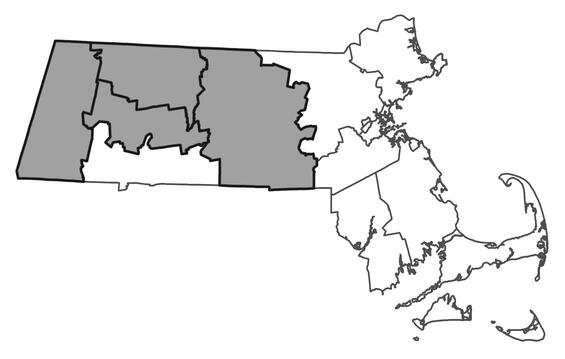- Scientific name: Cypripedium parviflorum
- Species of Greatest Conservation Need (MA State Wildlife Action Plan)
- Endangered (MA Endangered Species Act)
Description
All three varieties of yellow lady’s-slipper are herbaceous perennials in the orchid family (Orchidaceae).
Woodland yellow lady’s-slipper (C. parviflorum var. pubescens [Willd.] Knight) reaches heights of 30-60 cm (about 12-24 in). The blossoms have a bright yellow lip that is enlarged into a hollow, inflated pouch (the slipper), that is 3-5.4 cm (1-2.25 in) long, two spirally twisted side petals that are 5-8 cm (2-3 in) long, and two broad sepals, one above and one below the pouch. The pouch is often speckled with crimson spots inside and is usually veined with dark red along the "pleats" of the pouch. The 3-6 leaves are usually broader than those of the small variety, the sepals and petals are typically greenish brown rather than purplish brown, and the flower has a musky odor.
Small yellow lady’s-slipper (Cypripedium parviflorum var. makasin [Farw.] Sheviak) may vary between 12-43 cm (5-17 inches) in height. It sends up one or two showy, highly fragrant flowers from a single stalk with between two to five, large, oval or elliptic leaves with prominent veins. The sepals (members of the outermost floral whorl) and side petals are purplish to reddish brown, or mahogany-colored. The pouch averages 1.5-3 cm (0.75-1 in) in length and has a pleasant (some would say intensely sweet) vanilla fragrance. The fruit is an ellipsoid capsule (a type of dry fruit derived from a compound pistil).
Finally, while similar, southern small yellow lady’s-slipper (C. parviflorum var. parviflorum Salisb.) has a pouch similar in length to the small yellow lady’s-slipper, 1.5-3 cm (0.75-1 in), but its uppermost sheathing bract is conspicuously pubescent (in small yellow lady’s-slipper, the bract is glabrous or inconspicuously pubescent). This species also has a strong, sweet, floral scent similar to roses or musk.
Yellow lady’s-slipper flower is similar to the common pink lady’s-slipper and rare showy lady’s-slipper in shape; however, it is yellow, while these are pink or pink and white.
Life cycle and behavior
Yellow lady’s-slipper are herbaceous perennials.
Population status
Yellow lady’s-slipper (all varieties) is listed under the Massachusetts Endangered Species Act as Endangered. All listed species are protected from killing, collecting, possessing, or sale and from activities that would destroy habitat and thus directly or indirectly cause mortality or disrupt critical behaviors. The MassWildlife’s Natural Heritage & Endangered Species Program database has 44 records from 9 counties: Berkshire, Essex, Franklin, Hampden, Hampshire, Middlesex, Norfolk, Plymouth, and Worcester. Twenty-one of these records have been observed within the last 25 years.
Distribution and abundance
The documented range of yellow lady's-slipper extends from Newfoundland to Alaska south to California and Georgia. It is not known to occur in Oregon, Nevada, Texas, Louisiana or Florida. Yellow lady’s-slipper is also considered rare in Vermont, New Hampshire, Quebec and New Brunswick. As the different varieties have been ranked separately by the states, it is difficult to make a generalization about the species’ rarity outside of Massachusetts.

Distribution in Massachusetts
1999-2024
Based on records in the Natural Heritage Database
Habitat
Woodland yellow lady’s-slipper (var. pubescens) is found in upland deciduous forests. Associated species may include columbine, wild leek, blue cohosh, and plantain-leaved sedge; it may also be found in calcareous swamps.
Small yellow lady’s-slipper (var. makasin) grows in swamps and semi-open calcareous fens, especially in limestone wetlands. It prefers light to moderate shade. Other plants found growing with small yellow lady's-slipper include red maple (Acer rubrum), black ash (Fraxinus nigra), spicebush (Lindera benzoin), purple-stemmed aster (Symphyotrichum puniceum), skunk cabbage (Symplocarpus foetidus), Pennsylvania bitter cress (Cardamine pensylvanica), rough bedstraw (Galium asprellum), naked mitrewort (Mitella nuda), and cinnamon fern (Osmunda cinnamomeum). Other rare plants found in association with small yellow lady’s-slipper include showy lady's-slipper (Cypripedium reginae), hemlock parsley (Conioselinum chinense), and swamp red currant (Ribes triste).
Southern small yellow lady’s-slipper (var. parviflorum) was recently rediscovered in the state on a power line right-of-way through an upland forest.
Healthy habitats are vital for supporting native wildlife and plants. Explore habitats and learn about conservation and restoration in Massachusetts.
Threats
Yellow lady’s-slipper has apparently declined significantly in this state, possibly due to habitat loss from reforestation from natural succession, filling of wetlands, and the alteration of natural water levels, including changes caused by beaver. Non-native invasive species occur in the yellow lady’s-slipper habitats in Massachusetts; when these are abundant, they can compete for space and can be a threat to yellow lady’s-slipper.
Conservation
Monitoring and removal of competing vegetation should be considered as a management strategy where appropriate. All active management of rare plant populations (including invasive species removal) is subject to review under the Massachusetts Endangered Species Act and should be planned in close consultation with MassWildlife’s Natural Heritage & Endangered Species Program.
References
NatureServe. 2015. NatureServe Explorer: An online encyclopedia of life [web application]. Version 7.1. NatureServe, Arlington, Virginia. Available http://www.natureserve.org/explorer. (Accessed: May 13, 2015 ).
Haines, A. 2011. Flora Novae Angliae. New England Wild Flower Society. Yale University Press, New Haven, CT.
Contact
| Date published: | April 15, 2025 |
|---|